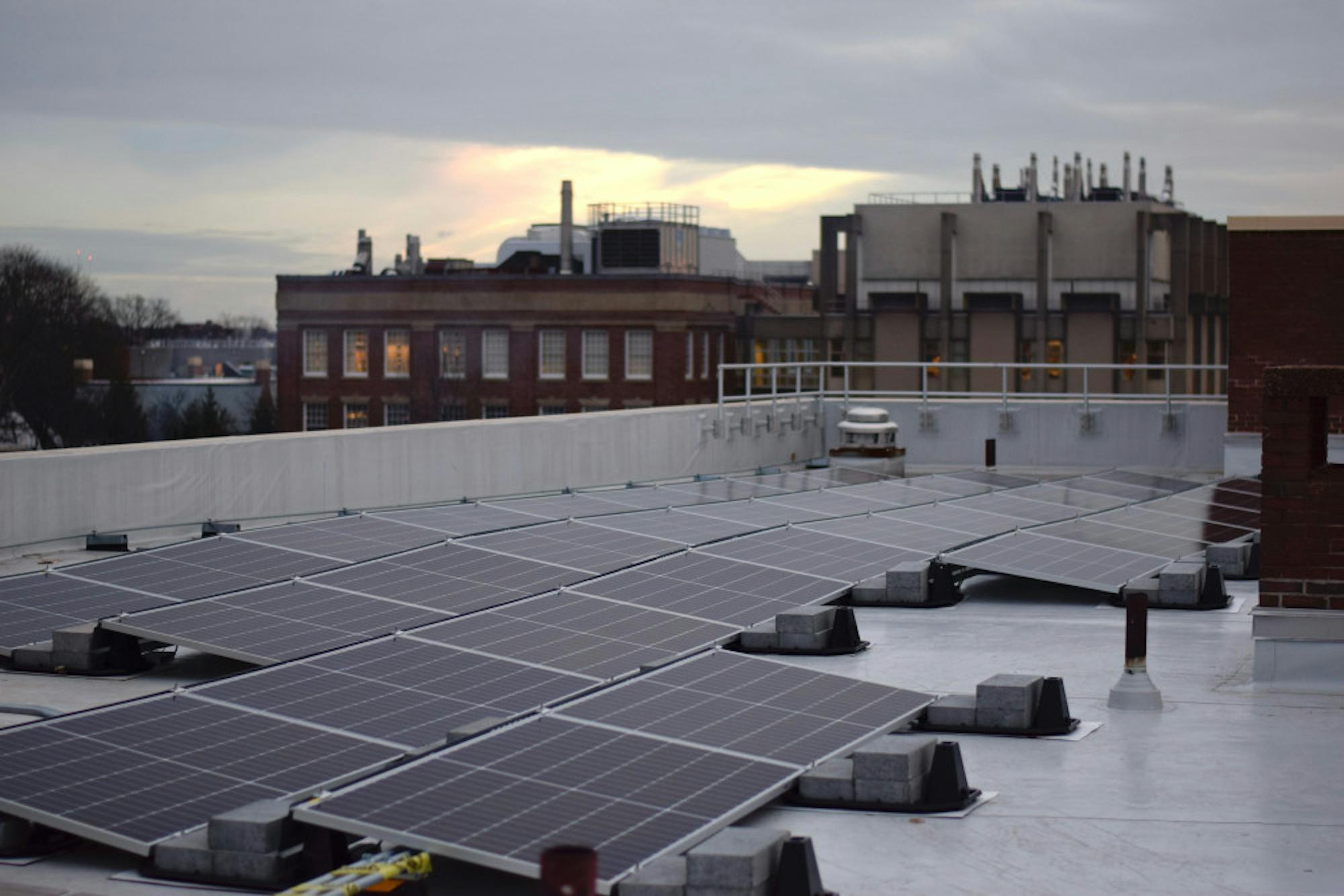Tufts is pursuing the widespread installation of solar panels across the Medford/Somerville campus that could, if fully implemented, bring Tufts toward its goal of being carbon-neutral by 2050.
An array of solar panels was recently installed on the roof of Lewis Hall, Tufts Director of Engineering for Facilities Services and Office of Sustainability Council Member Dariusz Raczkowski told the Daily in an email.
The array consists of 216 solar panels and will produce about 100,000 kilowatt hours of energy each year according to data provided by Director of Capital Programs Gretchen Von Grossmann.
This will save the university an estimated $118,000 over a 20-year period, Ruth Bennett, director of strategic capital programs at Tufts, told the Daily in an email.
Although the installation is finished, the metering infrastructure still needs to be installed before the array will go online, according to Raczkowski.
Lewis Hall is not the first building at Tufts to receive solar panels. According to Raczkowski, in 1998 and 1999, a student-driven effort resulted in the installation of two solar thermal panels and a photovoltaic (PV) panel on the Schmalz House, where the French language house is currently located.
“Tufts Climate Initiative was trying to lean on the university to start reducing carbon emissions,” Ann Rappaport, co-chair of the Sustainability Council and former co-director of the Tufts Climate Initiative, said.
The project also included the addition of new boilers, lighting, insulation and controls, according to Raczkowski.
“The point for me that was so exciting is it's a house just like all the others on the street. It’s a way to demonstrate to the community how easy it is,” Rappaport, who is also a senior lecturer in the Department of Urban and Environmental Policy and Planning (UEP), said.
Tina Woolston, the sustainability program director at the university, told the Daily in an email that Tufts does not have a budget allocated towards renewable energy infrastructure.
In recent years, Tufts has instead been able to install solar arrays free of charge through Power Purchase Agreements (PPAs), according to Woolston.
According to the Solar Energy Industry Association, PPAs are contracts in which a developer funds the purchase and installation of a solar energy system on a customer's property, and then sells the renewable energy credits generated by that solar system to the customer so it can meet renewable energy requirements. The customer benefits because they can negotiate a price per kilowatt-hour to pay the developer for the power produced by the solar panels.
In 2012, Tufts put together a strategic energy planning team and began working with Power Options, a Massachusetts-based energy-buying consortium, to manage its involvement with PPAs, according to Woolston.
She said that Tufts completed two PPA projects in June 2017 on the Grafton campus.
The twenty-year commitment involves two solar installations that generate three megawatts of electricity, which will provide power for 40 percent of the Grafton campus and save Tufts about $5.3 million, according to Woolston.
“What we get out of it is cheap electricity,” Rappaport said. “That’s really attractive to the deans because they can balance their budgets.”
In 2014, as part of Medford’s “Solarize Medford” campaign, SunBug Solar installed solar PV panels on top of Dowling Hall, according to Woolston.
The Lewis Hall array is part of a PPA Tufts established with the commercial energy company Solect Energy earlier this year, according to Von Grossman.
The agreement will also lead to the installation of a solar array on the Science and Engineering Center, according to Raczkowski, who estimated that the planned system will save the university $1,100 per year.
Raczkowski said that the Gantcher Center is being evaluated for further installations which could, if implemented, save the university $20,000 a year.
There are plans to install a solar array of 30 panels on a newly constructed CoHo housing, which will produce 1,000-kilowatt-hours annually, according to Raczkowski.
Tufts currently receives about 10 percent of its electricity through local PPAs. Less than one percent of electricity comes from solar arrays owned by Tufts, Raczkowski said.
Woolston said Tufts is seeking to create more Tufts-owned solar going forward.
“Tufts' latest carbon-neutral planning efforts include evaluating the type of budget that would be required if Tufts chose to own renewable energy sites,” Woolston said.
Woolston said that Tufts has contracted Ramboll Group, a Danish multidisciplinary consulting film, to head the planning efforts. Woolston said that the company will provide options for the university to become carbon-neutral by 2050.
“We are looking for all the money we can to [work toward] energy efficiency as quickly as possible, because if we get super energy efficient in our buildings, then it takes less renewable power to power those buildings,” Rappaport said. “It's all driving towards the same end.”
Tufts adds solar array to Lewis Hall, grows solar program

The solar panels on the roof of Lewis Hall are pictured on Dec. 5.





